Attached files
| file | filename |
|---|---|
| 8-K - 8-K - GUGGENHEIM CREDIT INCOME FUND 2019 | ccif-iform8xk2017q1overview.htm |
 | Exhibit 99.1 | |
CAREY CREDIT INCOME FUND
FIRST QUARTER 2017 OVERVIEW
This overview contains details about the portfolio and operating results for the quarter ended March 31, 2017 of Carey Credit Income Fund ("CCIF" or the "Company") and its feeder funds, Carey Credit Income Fund — I ("CCIF - I") and Carey Credit Income Fund 2016 T ("CCIF 2016 T"). This overview should be read in conjunction with the CCIF - I and CCIF 2016 T Quarterly Reports on Form 10-Q, which each incorporate the CCIF Quarterly Report on Form 10-Q, as filed with the U.S. Securities and Exchange Commission (the "SEC") on May 15, 2017.
CCIF First Quarter 2017 Portfolio Highlights
• | As of March 31, 2017, CCIF had total assets of $382 million, compared to total assets of $305 million as of December 31, 2016. |
• | For the three months ended March 31, 2017, CCIF invested $87 million, 64% of which was in directly originated debt investments. For the year ended December 31, 2016, CCIF invested $268 million, 51% of which was in directly originated debt investments. |
• | CCIF's portfolio investments at fair value totaled $330 million as of March 31, 2017, of which 90% was in senior secured investments. The portfolio consisted of 82 investments across 61 portfolio companies. |
• | CCIF's gross portfolio yield as of March 31, 2017 was 7.9%, compared to 8.2% as of December 31, 2016.1 |
• | As of March 31, 2017, CCIF had one debt investment on non-accrual status, which represented 1% of total investments on both a fair value basis and an amortized cost basis. |
First Quarter 2017 Public Offering Highlights
• | Please see below for offering-specific highlights for the quarter ended March 31, 2017: |
Three Months Ended March 31, 2017 | ||||
CCIF - I | CCIF 2016 T | |||
Distributions paid per share | $0.45 | $0.16 | ||
Total investment return (net asset value, non-annualized)2 | 2.58 | % | 2.42 | % |
Net asset value per share | $25.95 | $9.17 | ||
Gross proceeds from offering ($ in thousands) | $9,439 | $49,197 | ||
• | CCIF 2016 T concluded its public offering on April 28, 2017, having raised $164 million since inception. |
• | As of March 31, 2017, CCIF - I raised cumulative gross proceeds of $29.3 million since inception. |
________________________
(1) | Weighted average effective yield is calculated as the effective yield of each investment and weighted by its amortized cost as compared to the aggregate amortized cost of all investments. Effective yield is the return earned on investments net of any discount, premium, or issuance costs. Effective portfolio yield for the total debt portfolio is calculated before considering the impact of leverage or any operating expenses, and cash, restricted cash, non-income producing assets and equity investments are excluded. |
(2) | Total investment return-net asset value is a measure of the change in total value for shareholders who held the company’s common shares at the beginning and end of the period, including distributions declared during the period. Total investment return-net asset value is based on (i) net asset value per share on the first day of the period, (ii) the net asset value per share on the last day of the period, plus any shares issued in connection with the reinvestment of monthly distributions, and (iii) distributions payable relating to the ownership of shares, if any, on the last day of the period. The total investment return-net asset value calculation assumes that (i) monthly cash distributions are reinvested in accordance with the Company’s distribution reinvestment plan and (ii) the shares issued pursuant to the distribution reinvestment plan are issued at the then current public offering price, net of sales load, on each monthly distribution payment date. Since there is no public market for the company’s shares, terminal market value per share is assumed to be equal to net asset value per share on the last day of the period presented. Investment performance is presented without regard to sales load that may be incurred by shareholders in the purchase of the company’s common shares. The company’s performance changes over time and currently may be different than that shown above. Past performance is no guarantee of future results. Total investment return-net asset value is not annualized. |
- 1 -
Business Environment
Midway through the first quarter of 2016, the commodity markets rebounded and high yield and leveraged loans began a streak of strong performance that continued into February of 2017. In March, spreads were driven wider by declining oil prices and by a few struggling high-profile names in the retail sector, in spite of a Federal Reserve rate hike in mid-March.
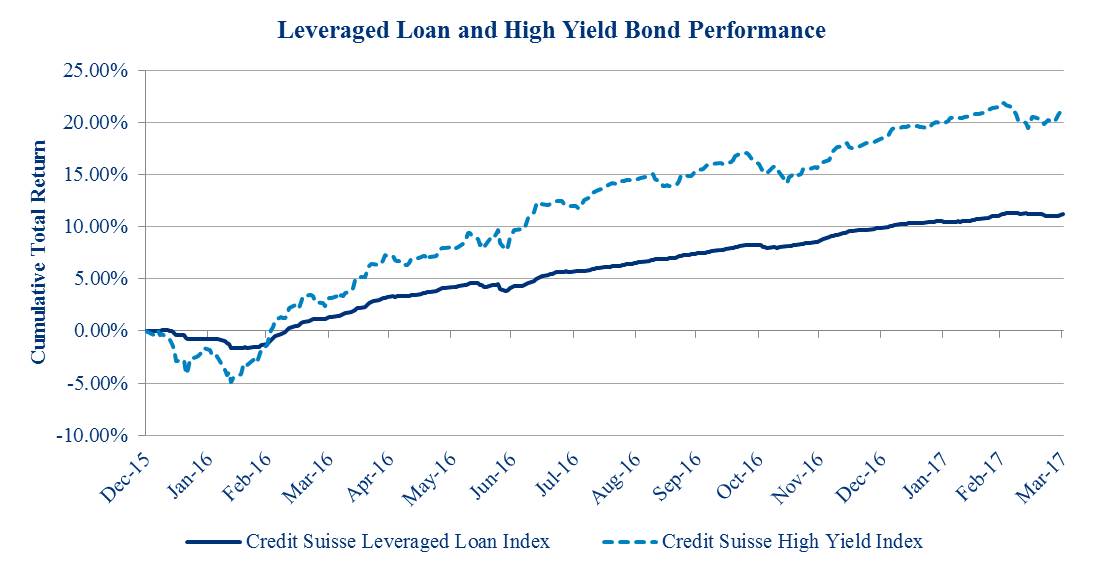
Although we saw the slight widening of spreads in March, quarter-over-quarter loan spreads contracted as borrowers took advantage of strong market demand to push pricing lower (i.e. refinancing for lower cost of capital in the tight market).
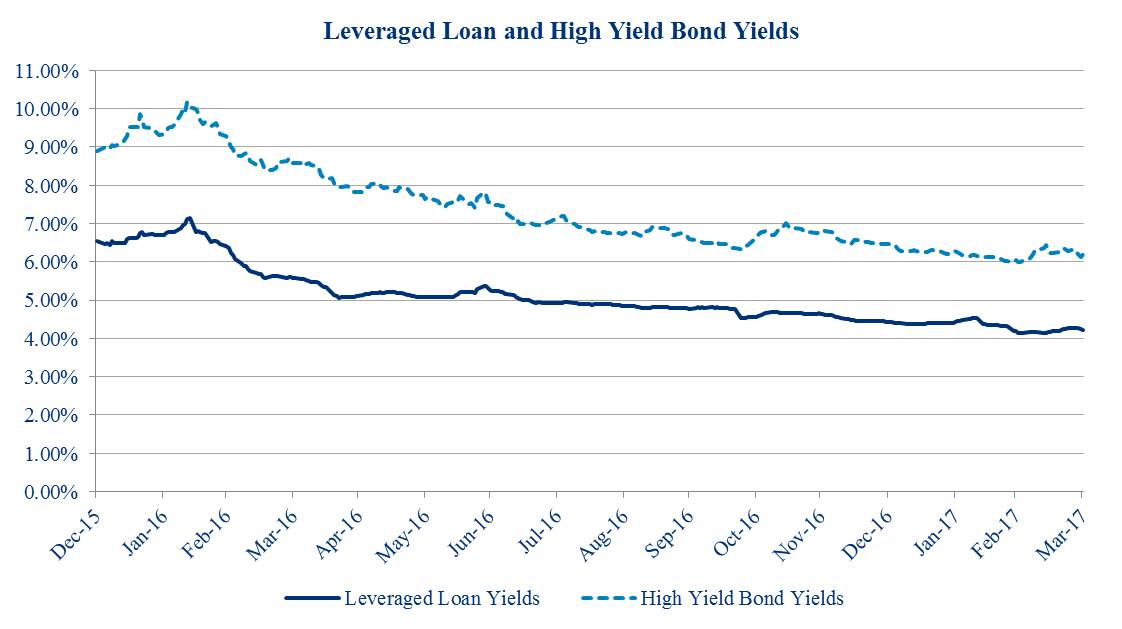
Improved sentiment along with steady market demand for leveraged loans and high yield bonds contributed to a surge in new issuance volume in the first quarter. U.S. institutional leveraged loan issuance volume totaled $169 billion, up 316 percent from the first quarter of 2016, and well-above the previous quarterly record of $149 billion set in 2013, according to S&P LCD. The exceptional new issuance volume was driven by a resurgence in refinancing activity as borrowers opportunistically reduced their cost of debt. Refinancing historically averages 43 percent of total new-issue volume across high-yield corporate bonds and bank loans. In 2016 and the first quarter of 2017, however, it totaled 52 percent and 66 percent of volume, respectively.
- 2 -
Leveraged credit fundamentals remain intact and will likely continue to improve as the outlook for earnings remains positive. Concurrently, default rates in the space remain below historical averages (approximately 4% per year since 1983) and are concentrated in specific industries such as energy, metals and mining, and specialty retail. Additionally, refinancing activity and strong demand from institutional investors and mutual funds have pushed yields lower, as prices increase and spreads continue to tighten. These factors serve to underscore a lack of attractive risk adjusted return opportunities in the syndicated market.
We believe that, in this credit environment, experienced credit managers such as CCIF's Advisors - Guggenheim Partners, LLC ("Guggenheim") and W. P. Carey ("WPC") - are critical to the success of credit investors. While we remain constructive on credit and will be opportunistic during times of technical dislocations in the syndicated markets, we believe that direct origination will be the primary source of opportunity in the near term. We believe that CCIF's Advisors' extensive resources in credit research and direct origination capabilities will allow us to continue investing in new assets with attractive yields while remaining in the senior credit position of portfolio companies' capital structures to protect against the downside when the market conditions shift.
Investment Activity, Investment Performance, and Portfolio Update
As the syndicated bank loan markets remain competitive, we continue to see lower yields and fewer loan covenants making the syndicated market less attractive for sourcing debt investments from a risk/reward standpoint. As such, our investment focus remains concentrated in directly originated investments, where we seek attractive yields that allow us to largely remain in senior positions of companies' capital structures.
During the quarter ended March 31, 2017, our investment activity was primarily concentrated in sourcing debt investments through direct origination (64%) and primary issuance channels (21%) and the remainder was through secondary market channels (i.e. syndicated investments). Investment activity consisted of $87 million in new commitments, including commitments to eight new portfolio companies.
The following table presents our investment activity for the three months ended March 31, 2017 and March 31, 2016 (dollars in thousands):
Three Months Ended March 31, 2017 | Three Months Ended March 31, 2016 | ||||||
Total Assets | $ | 382,198 | $ | 106,051 | |||
Total Fair Value of Investments | $ | 330,040 | $ | 86,785 | |||
Gross Portfolio Yield | 7.9 | % | 8.2 | % | |||
Investment activity segmented by access channel: | |||||||
Direct origination | $ | 55,704 | - | ||||
Primary issuance | 18,304 | 9,849 | |||||
Secondary market transactions | 12,771 | 6,876 | |||||
Total investment activity | 86,779 | 16,725 | |||||
Investments sold or repaid | (34,440 | ) | (7,824 | ) | |||
Net investment activity | $ | 52,339 | $ | 8,901 | |||
Portfolio companies at beginning of period | 55 | 32 | |||||
Number of added portfolio companies | 8 | 10 | |||||
Number of exited portfolio companies | (2 | ) | (3 | ) | |||
Portfolio companies at period end | 61 | 39 | |||||
- 3 -
As discussed above, while syndicated loan market yields continue to tighten, CCIF's investment focus is concentrated in directly originated transactions that are also senior secured in order to better protect investors against the downside when the market environment eventually shifts. During Q1 of 2017, only 3% of commitments were outside of senior secured first or second lien debt investments. Investment activity by quarter and by asset class as of each of the last four quarters was as follows:
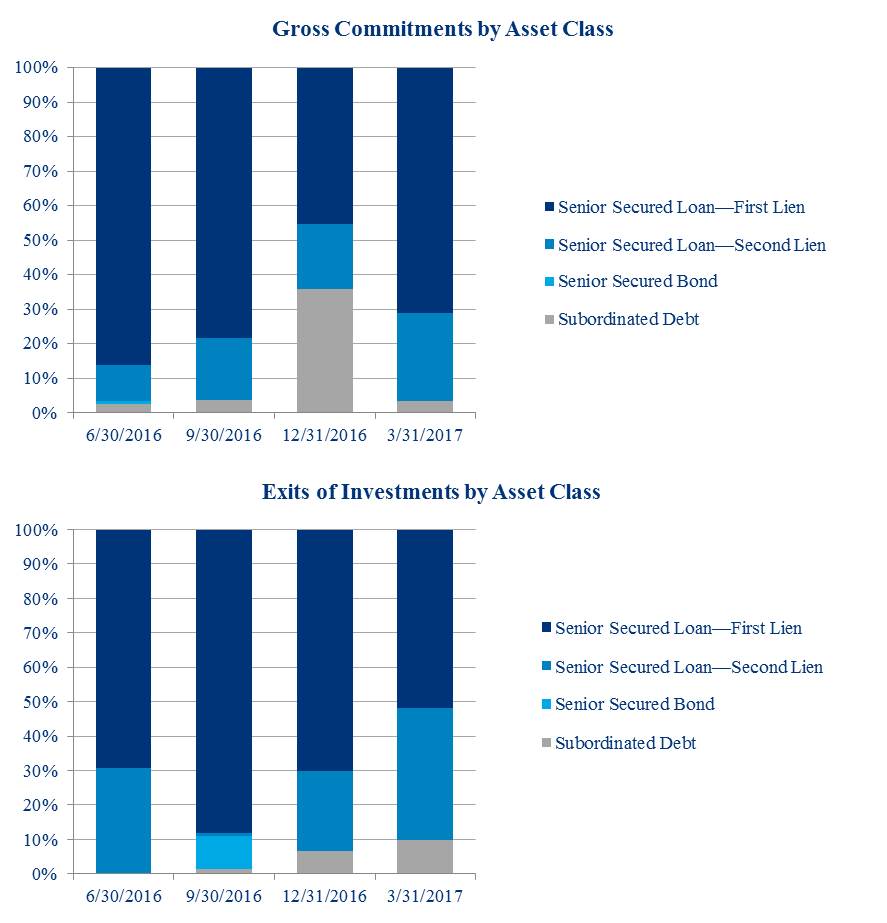
As of March 31, 2017, the portfolio consisted of $330 million of total investments at fair value and, consistent with prior quarters, our debt portfolio remains predominately invested in senior secured debt investments which represented 90% of the portfolio at fair value. We believe senior secured debt investments provide for downside protection which is particularly important given today's credit environment. Set forth below is the composition of the portfolio by asset class for each quarter end based on fair value:
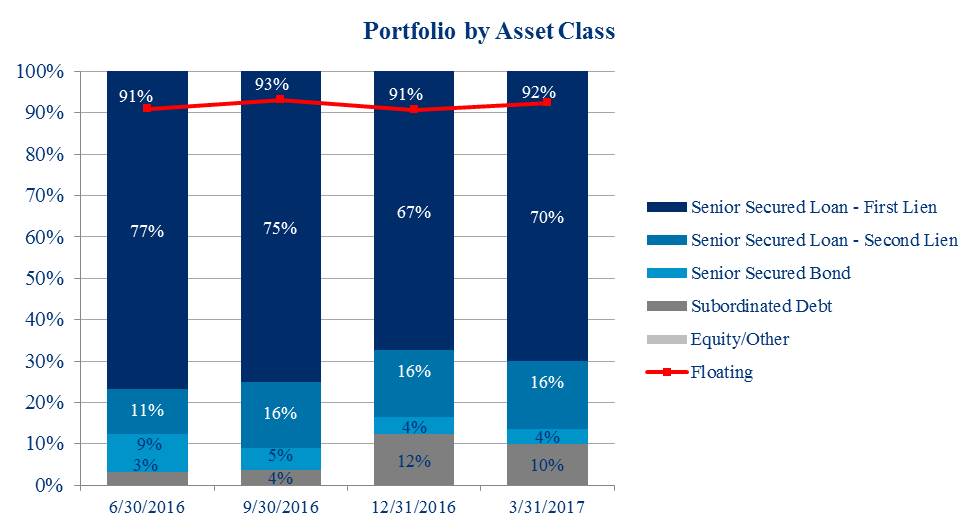
- 4 -
As of March 31, 2017, there were 61 portfolio companies in which CCIF held 82 investments. The weighted average portfolio company age, based on fair value, was 34 years as of March 31, 2017. Furthermore, and aligned with our strategy of mitigating industry specific risk, the companies comprising the CCIF portfolio were diversified across 19 industries. Set forth below are the industry concentrations in CCIF's portfolio as of March 31, 2017 by fair value:
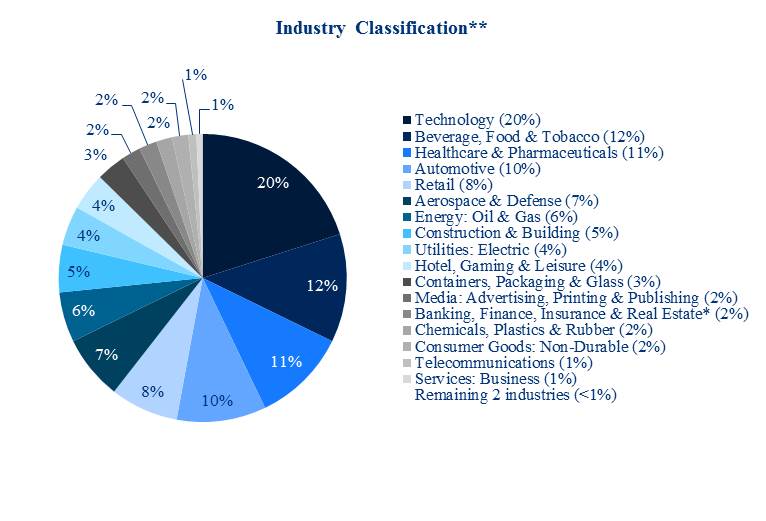
________________________
(*) Some portfolio companies in this category represent insurance brokers and are not classified as insurance companies.
(**) Industry classifications based upon Moody's standard industry classifications.
As spreads have tightened in the secondary market, CCIF's Advisors continue to actively deploy capital into directly originated transactions, maintaining a gross portfolio yield of 7.9% as of March 31, 2017, compared to 8.2% as of December 31, 2016 and 7.9% as of September 30, 2016.
Set forth below are the weighted average effective yields, by investment type, as of each of the prior four quarters:

- 5 -
Set forth below are the weighted average EBITDA, weighted average total leverage multiple, and weighted average interest rate coverage of CCIF's portfolio companies. The quarter-over-quarter decline in portfolio weighted average EBITDA was primarily due to the continued focus on directly originated transactions. The six new portfolio companies associated with direct originations had a weighted average EBITDA of $32.3 million and the two portfolio companies that were sold during the quarter had a weighted average EBITDA of $197.9 million.
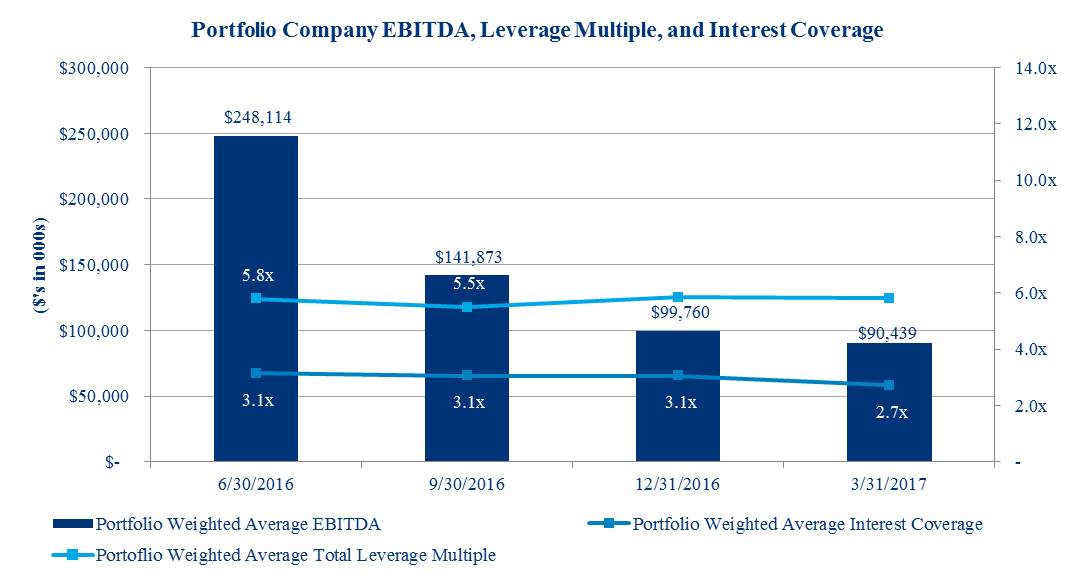
________________________
(3) | Weighted average EBITDA amounts are weighted based on the amortized cost of the portfolio company investments. EBITDA amounts are estimated from the most recent portfolio company financial statements, have not been independently verified by CCIF or its Advisors, and may reflect a normalized or adjusted amount. Accordingly, neither CCIF nor its Advisors makes any representation or warranty in respect of this information. |
(4) | Weighted average interest coverage represents the portfolio company’s EBITDA as a multiple of interest expense. Portfolio company credit statistics are derived from the most recently available portfolio company financial statements, have not been independently verified by CCIF or its Advisors, and may reflect a normalized or adjusted amount. Accordingly, neither CCIF nor its Advisors makes any representation or warranty in respect of this information. |
(5) | Portfolio weighted average EBITDA, weighted average total leverage multiple, and weighted average interest coverage ratio data includes information solely in respect of portfolio companies in which CCIF has a debt investment. |
(6) | EBITDA is a non-GAAP financial measure. For a particular portfolio company, EBITDA is generally defined as net income before net interest expense, income tax expense, depreciation and amortization. EBITDA amounts are estimated from the most recent portfolio company's financial statements, have not been independently verified by CCIF or its Advisors, and may reflect a normalized or adjusted amount. Accordingly, neither CCIF nor its Advisors makes any representation or warranty in respect of this information. |
- 6 -
As of March 31, 2017, CCIF had one debt investment on non-accrual status associated with one portfolio company in the Energy: Oil and Gas industry, which represented 1% of total investments on both a fair value and amortized cost basis. In May of 2016, the portfolio company voluntarily filed a petition to reorganize under Chapter 11 of the U.S. Bankruptcy Code, and the workout was still underway as of March 31, 2017. We are actively monitoring the situation and continuously evaluating our position.
The following chart shows debt investments on non-accrual status based on their amortized cost and fair value for each of the prior four quarters.
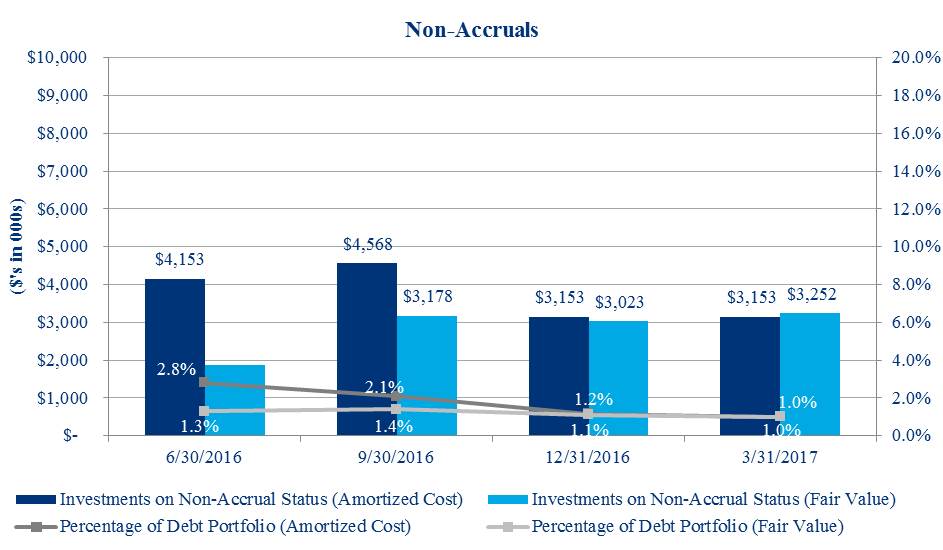
The following chart shows the maturity schedule of CCIF's debt investments, excluding unfunded commitments, based on their principal amount as of March 31, 2017.
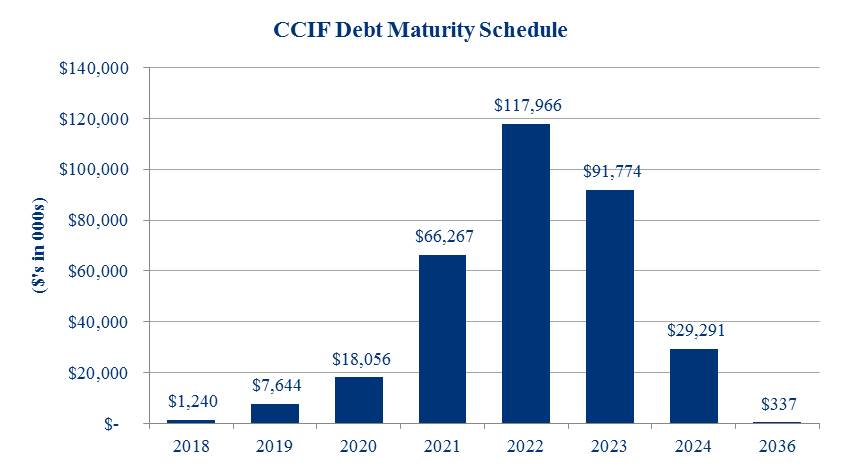
CCIF's publicly offered feeder funds, CCIF 2016 T and CCIF - I, which have committed to seek liquidity events on or before December 31, 2021 and December 31, 2040, respectively, collectively represented 80% of CCIF's total ownership as of March 31, 2017. The following chart shows the liquidity schedule of CCIF's publicly offered feeder funds as of March 31, 2017 based on the net assets of CCIF.
- 7 -
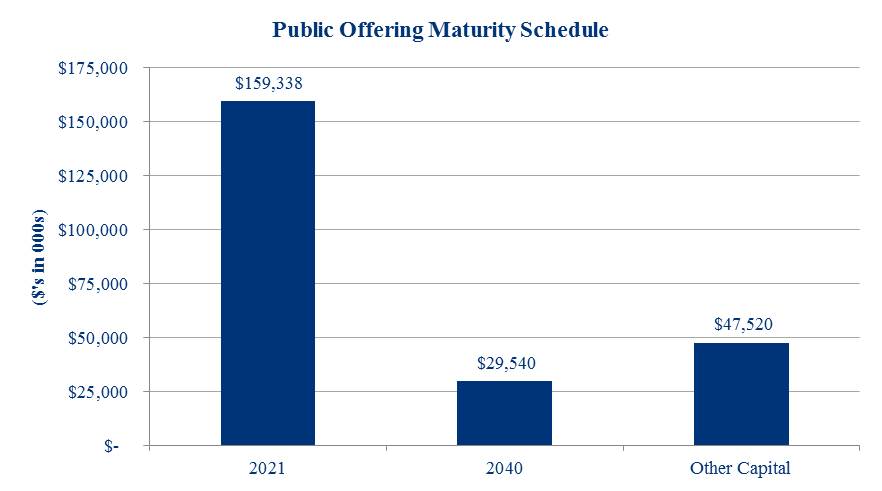
About Carey Credit Income Fund
CCIF is a non-traded business development company (BDC) that invests primarily in large, privately negotiated loans to private middle market U.S. companies. CCIF is the master fund which pools investor capital raised through its feeder fund offerings, such as CCIF - I and CCIF 2016 T. CCIF is managed by affiliates of WPC and Guggenheim and is designed to provide investors with current income, capital preservation, and, to a lesser extent, capital appreciation. CCIF and its feeder fund offerings share the same investment objectives and strategies and all portfolio investments and corporate borrowings are held at CCIF.
About W. P. Carey Inc.
Founded in 1973, WPC (NYSE: WPC) is a leading, internally-managed net-lease real estate investment trust that provides real estate-based financing solutions for companies primarily in the U.S. and Europe. WPC has expertise in credit and real estate underwriting, with more than 35 years of experience in evaluating credit and real estate investment opportunities. A capital provider to growing U.S. companies since its inception, WPC had an enterprise value of approximately $10.7 billion at March 31, 2017. In addition to its owned portfolio of diversified global real estate, WPC manages a series of non-traded publicly registered investment programs with assets under management of approximately $13.0 billion. WPC is subject to the information and reporting requirements of the Exchange Act. As a result, it files periodic reports and financial statements with the SEC, copies of which are available on the SEC's website at www.sec.gov.
For four decades, WPC has provided companies around the globe with capital to expand their businesses, make acquisitions, invest in research and development, or fund other corporate initiatives. Its corporate finance-focused credit and underwriting process is a constant that has been leveraged across a wide variety of companies and industries. WPC's investment process has largely focused on identifying companies with stable and improving credit profiles using a top-down and bottom-up approach, without relying on outside rating agencies. Credit-quality characteristics, capital structure, operating history, margin and ratio analysis, industry market share, and management team are all key considerations in evaluating and determining investment suitability of potential credits.
About Guggenheim Partners, LLC
Guggenheim Investments represents the investment management businesses of Guggenheim Partners and includes Guggenheim, an SEC-registered investment adviser. Guggenheim Partners is a privately-held, global financial services firm with over 2,300 employees and more than $260 billion in assets under management as of March 31, 2017. It produces customized solutions for its clients, which include institutions, governments and agencies, corporations, insurance companies, investment advisors, family offices, and individual investors.
- 8 -
Guggenheim Investments manages $217 billion in assets across fixed income, equity, and alternatives as of March 31, 2017. Its 250+ investment professionals perform research to understand market trends and identify undervalued opportunities in areas that are often complex and underfollowed. This approach to investment management has enabled Guggenheim to deliver long-term results to its clients.
Within Guggenheim Investments is the Guggenheim Corporate Credit Team, which is responsible for all corporate credit strategies and asset management of $74.8 billion. A unified credit platform is utilized for all strategies and is organized by industry as opposed to asset class, which increases its ability to uncover relative value opportunities and to identify and source opportunities. The scale of the platform, combined with the expertise across a wide range of industries and in-house legal resources, allows Guggenheim to be a solution provider to the market and maintain an active pipeline of investment opportunities.
Cautionary Statement Concerning Forward-Looking Statements
This document contains forward-looking statements within the meaning of the Federal securities laws. These statements are not guarantees of future performance and are subject to risks, uncertainties and other factors, some of which are beyond our control, are difficult to predict and could cause actual results to differ materially from those expressed or forecasted in the forward-looking statements. CCIF, CCIF - I, and CCIF 2016 T undertake no obligation to update any forward-looking statements contained herein to conform the statements to actual results or changes in their expectations. A number of factors may cause CCIF’s, CCIF - I's and CCIF 2016 T's actual results, performance or achievement to differ materially from those anticipated. For further information on factors that could impact CCIF, CCIF - I, and CCIF 2016 T performance, please review CCIF’s, CCIF - I's, and CCIF 2016 T's respective filings at the SEC website at www.sec.gov.
- 9 -
